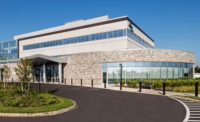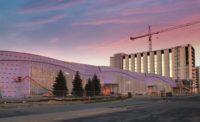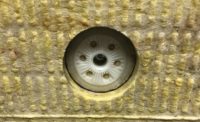One of the greatest advancements that occurred in the 20th century happened in 1913, in the Detroit area. This “advancement” that happened was Ford introducing the assembly line in order to mass produce cars at a cheaper rate. At the time, cars were time-consuming to build and were very expensive—meaning only the wealthy could afford them. Ford’s approach was to use non-skilled laborers (and lots of them) to do one or two simple and repetitive tasks all day every day, as car chassis’ rolled down the line. Thus, cars were produced quicker, cheaper and perhaps more importantly, identical every time.
So, what does this have to do with construction?
A growing trend in the construction industry is that of pre-fabricated or panelized construction. In many ways, it follows the same model as the assembly line method, as well as offering many of the same advantages when comparing building components of a structure. It allows for duplication in a controlled environment, with little to no variance from one component to the next. Thus, reducing build time and increasing accuracy.
Pros and Cons
There are certainly pros and cons to pre-fab construction. I am not going to argue that it’s the greatest advancement since the automotive assembly line. However, after being on many construction sites across the country, some pre-fab and some traditional, as well as visiting numerous shops that specialize in pre-fab, I am going to point out some of the advantages to this method of construction.
Looking outside from my desk brings up my first point of an advantage that pre-fab construction offers, climate controlled environments. It’s cold and snowy today, which makes it less than ideal for working outdoors. On the flipside, it’s also not fun to work outside when it’s 90 plus degrees.
Personal comfort aside, many products on the market today are sensitive to temperature. When looking at applying liquid applied WRBs, sealants, paints, etc., it can be tough in the dead of winter. The same issue arises with rain or air moisture content; it can make products nearly impossible to cure. All of these elements slow down construction progress, which can cause large headaches for all project stakeholders. Most importantly, when these “weather sensitive” products are installed in the proper environment, it can help ensure a better building envelope.
Let’s talk about every companies’ number one jobsite concern: safety. In more ways than one, pre-fab construction can be a lot safer than traditional styles of jobsite construction. In a factory, there are often many safety stops in place in order to prevent injuries. The factory environment is quite a bit different than working ten stories up, erecting walls or attaching cladding on a windy day. There is mitigated risk of fall hazards (for both people and materials).
There may be another less obvious safety advantage to factory construction as well, and that is less worker fatigue. Many of the tasks or stations in pre-fab construction, if thought out well ahead of time, are designed to reduce fatigue and stress on the workers. From additions of overhead cranes to quickly lift heavier wall sections, or tools designed to be more ergonomic, the underlying intent is to help workers be more productive in a less strenuous way. With higher turnover in the labor force, senior and veteran contractors retiring, and younger less experienced workers coming into the industry, safety concerns must always be at the forefront.
Advantages
I think it’s safe to say, that in many ways, panelization can be less environmentally wasteful as well. When engineering and designing these processes from front to end, it can be done in such a way that maximizes all raw inputs. I’ve seen a few great examples of this at various panelization shops. Some shops use foam cutters that can be programmed to cut exact sizes and shapes needed for wall panels. This allows them to have very little waste left, in comparison to the alternative of buying sheets of insulation and cutting as necessary.
Other shops are using their own processing equipment to cold roll their own steel studs, thus preventing them from having to buy and cut various types. This allows them to control the entire production. Another example is less waste through controlled processes. For something as seemingly simple as applying a liquid applied air barrier, there can be a lot of waste when done on the jobsite. Some parts may be too thick, or too thin, or wind is blowing causing a percentage of it to evaporate. It is much easier to control these types of applications in a factory setting.
A couple years ago, we provided materials for a project that was being built in Lansing, Mich. This particular building was massive, it was ten stories tall and had well over 190,000 square feet of wall space. The interesting thing about this building was that although it was being assembled in Lansing, the wall panels were being built down south, about 700 miles from the project.
Panelizers
This brings up another interesting aspect of pre-fab construction, it’s not limited by geography or labor pool. For markets where there is a mass labor shortage, or a lack of skilled workers, this provides an opportunity for panelizers. Essentially, this type of construction really means there are no longer geographical barriers. Obviously, this wouldn’t work on all projects or always make financial sense but it is interesting nonetheless, that in this case it was the most cost effective option for this project.
Last, let’s discuss something that makes our lives easier every day: technology. Many pre-fab firms utilize technology to increase output, ensure accuracy, and track processes. Often, computers and software, along with high-tech machinery are only feasible in a factory setting and not on a jobsite.
One such firm that utilizes high-tech processes is South Valley Prefab in Denver. Travis Vap, CEO of South Valley Prefab, says: “Technology allows us to fabricate at a quality level that isn’t commonly seen in the construction industry. We are a paperless facility and have customized software solutions to run our facility. Every panel receives a QR code and is inspected at every step of the process from fabrication through erection.” Travis goes on to say, “This process gives owners and contractors a lot of confidence in our ability to build and deliver a high-quality panel system.”
The Answer?
So, is pre-fab or panelized construction the answer for all new construction? Certainly not. Pre-fab or panelized construction are often ideal for buildings like hotels, apartments, and various types of other housing where construction is the same room to room. There are many limitations still with this method of construction. For one thing, once you commit to a design in the planning stage and implement it, you’re stuck with it. There is very little room for any changes once this process begins. Additionally, this method of construction only works on “cookie cutter” type projects. The whole point of this is to be able to build each wall section, truss, room, etc., the exact same way. Changes from section to section only slow this process, adding costs and making it extremely cumbersome.
Even though pre-fab construction isn’t right for every project, hopefully this article at least opens your eyes to some of the potential advantages it has to offer. In the 2017 Forbes article, “The Rise of the Prefabricated Building,” Tom Hardiman (Modular Building Institute executive director), was quoted saying: “No one would question how we build cars today. It would be comical to have all the parts delivered to your driveway with a dozen workers to build it. Yet, we build our homes, schools and offices in this inefficient and wasteful manner every day.”









